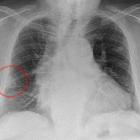Hampton hump


Hampton hump refers to a dome-shaped, pleural-based opacification in the lung most commonly due to pulmonary embolism and lung infarction (it can also result from other causes of pulmonary infarction (e.g. vascular occlusion due to angioinvasive aspergillosis). While a pulmonary embolism is expected to result in a wedge-shaped infarction, the expected apex of this infarction may be spared because of collateral supply from the bronchial arterial circulation, leading to the characteristic rounded appearance of a Hampton hump.
Opacification occurs secondary to hemorrhage due to the dual blood supply from the bronchial arteries (see lung infarction). In the case of infarction, it takes months to resolve, and it often leaves a linear scar.
If the underlying parenchyma does not undergo infarction, the Hampton hump will resolve within a week by keeping its typical configuration. This is referred to as the melting sign because its resolution resembles a melting ice cube .
History and etymology
It was originally described in 1940 by Aubrey Otis Hampton (1900-1955) , an American radiologist.
See also
Siehe auch:
- Westermark-Zeichen
- Lungenarterienembolie
- Melting ice cube sign (lungs)
- Lungeninfarkt
- Fleischner sign
- Bronchialarterie
- Röntgenzeichen bei Lungenembolie
und weiter:

 Assoziationen und Differentialdiagnosen zu Hampton hump:
Assoziationen und Differentialdiagnosen zu Hampton hump:


